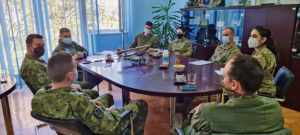
Airmen from the 435th Contingency Response Support Squadron and the 606th Air Control Squadron traveled to Croatia to host a class from March 15th to April 2nd for Croatian and Slovenian air force military students to increase their Control and Reporting Center’s capabilities.
CRCs are vital in guiding aircraft through their assigned area during a mission. They also enhance Agile Combat Employment capabilities by making sure CRCs operated by partner countries and allies can speak the same tactical language.
“CRCs are responsible for battle management, weapons control, surveillance and link management,” said U.S. Air Force Staff Sgt. Corey Farmer, 606th ACS exercises and plans noncommissioned officer in charge. “We tactically control aircraft and identify any other aircraft within our area of responsibility through the surveillance technicians via radar feeds or tactical data links. At the end of the day, we deconflict aircraft and get them overhead of whoever is requesting them.”
Farmer served as a subject matter expert during the course, ensuring the students would be prepared for an upcoming exercise.
“We are preparing them for Astral Knight 21, which is a multinational exercise that stresses the importance of cooperation between us and NATO allies,” Farmer said. “The main focus of the class was getting the Croatian and Slovenian controllers prepared to control with new communication standards.“
The goal of the three-week course was to certify the students as either master controllers or intercept controllers. It also served as a force multiplier.
“The training conducted prepared these students to train and certify members of their Croatian and Slovenia air forces respectively,” said U.S. Air Force Tech. Sgt. James Stewart, 435th CRSS security forces air advisor. “This training ensured that our partners are in line with NATO standards and are able to be self-sufficient in maintaining this critical capability.”
While the tactical benefits are clear, there were also intangible gains such as building personal relationships and expanding perspectives.
“During the class I got to see a different point of view than I would traditionally get from U.S. Air Force CRCs,” said U.S. Air Force Airman 1st Class John Roache, 606th ACS weapons director. “That includes operating on a different system with different techniques and standards for accomplishing the same mission.”
Classes like this increase interoperability between the U.S. and NATO partners and are important to security and mission success throughout the region.
The 435th CRSS Air Advisors are security cooperation experts who specialize in building partner capacity and building partnerships, a critical element to furthering U.S. and NATO objectives. Air Advisors use their security cooperation skills to think strategically, bridge operationally, and execute tactically to aid partner nations in advancing their interoperability.


